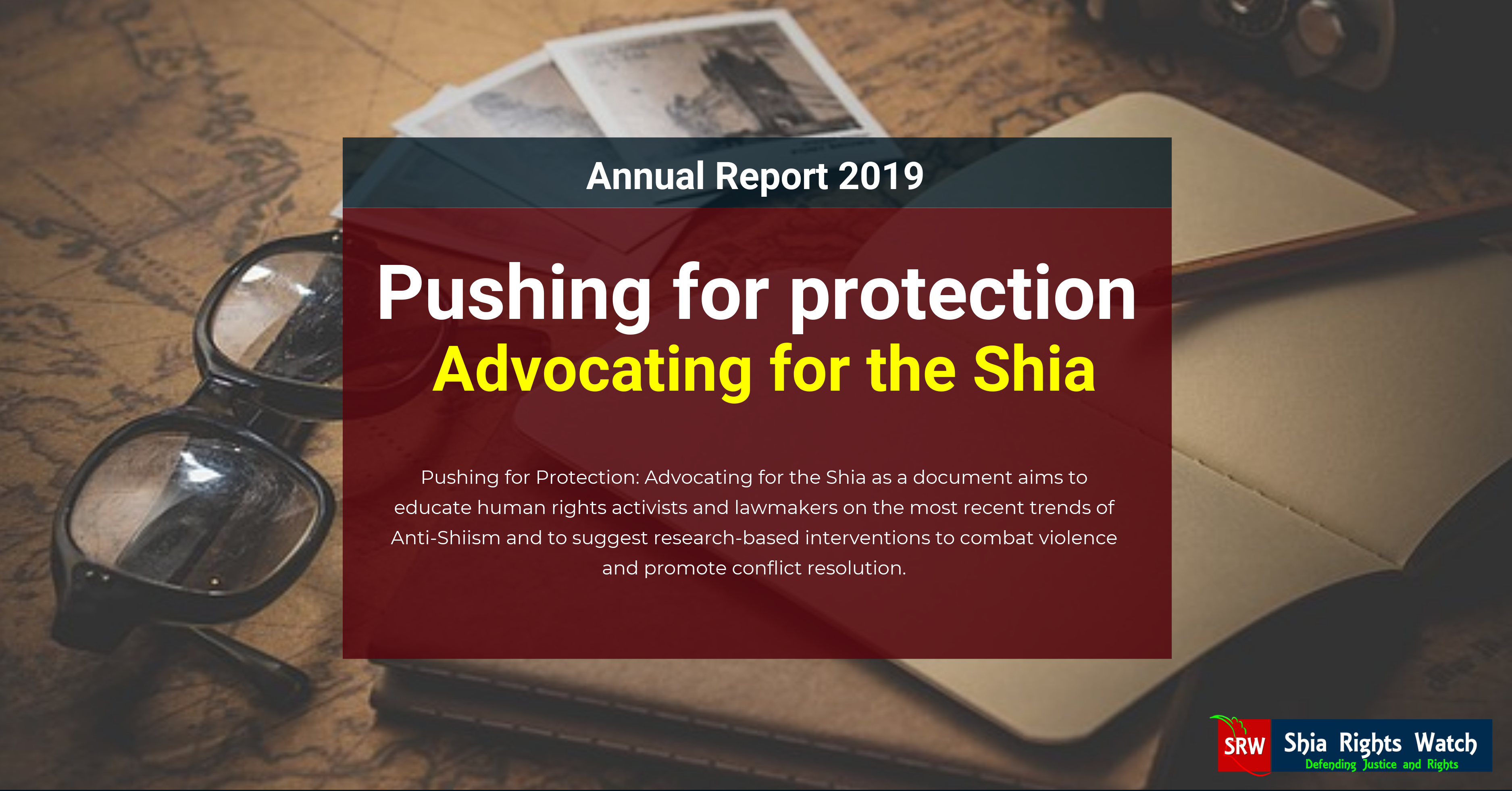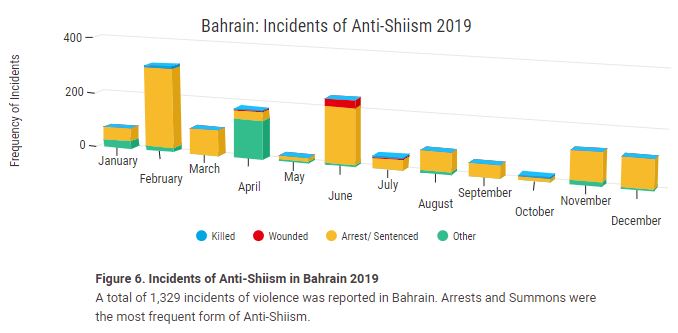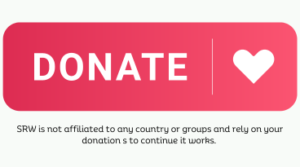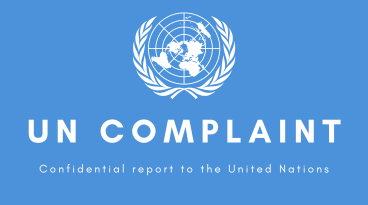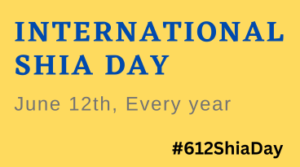Annual Report 2019
In this report, Shia Rights Watch quantifies violence against Shia Muslims and presents the dynamics of anti-Shiism in various nations of the world. This report reflects year-round investigations arranged by native activists and international researchers on actions taken to endanger populations based on their Shia identity.
Pushing for Protection: Advocating for the Shia as a document aims to educate human rights activists and lawmakers on the most recent trends of anti-Shiism and to suggest research-based interventions to combat violence and promote conflict resolution.
Anti-Shiism is a term used to denote actions that directly or indirectly, actively, or through complacency, promote hatred, violence, or prejudice motivated with the aim of detriment towards the Shia Muslim identity.
While violence in the forms mentioned above has existed for centuries, anti-Shiism has only recently been recognized by the international community.
It is important to note that this report represents only a fraction of insight into modern-day anti-Shiism. This report neither reflects all of the work Shia Rights Watch does in terms of which countries we investigate for human rights violations, nor does it showcase every single Shia human rights violation. Many forms of anti-Shiism are unquantifiable. Moreover, many incidents of violence are not reported due to fear of persecution or as a result of restricted communication resources. 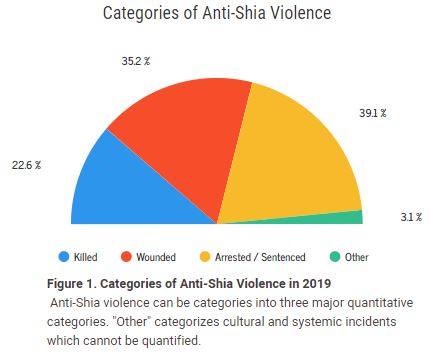
Shia Rights Watch emphasizes that acts of violence included in this report are ones who were explicitly motivated by the religious identity of victims. Only the death of civilians is contained in this report. Reports of death as a function of political motivations are not included.
More information in regards to specific incidents of violence can be found on ShiaRightsWatch.org, including but not limited to, monthly analyses that detail anti-Shiism.
2019
Between January 1, 2018, and December 31, 2019, the international Shia community experienced 3,537 incidents of violence. Violence against Shia Muslims was varied and diverse in form. Imprisonment, denaturalization, injury, loss of life, life-sentences, kidnapping, denial of services, arrests, and property damage are just some forms of anti-Shiism recorded by Shia Rights Watch.
Updated Numbers
Of the incidents reported to Shia Rights Watch, 1944 were concentrated between July 1 and December 31.
Incidents of anti-Shiism increased by 22% in the second half of the year. The spike in numbers is mainly a function of incidents of mass violence in Afghanistan. Historically, due to the rituals that emphasize congregation and communality in the holy month of Muharram, Shia Muslims are at increased risk for targeted violence.
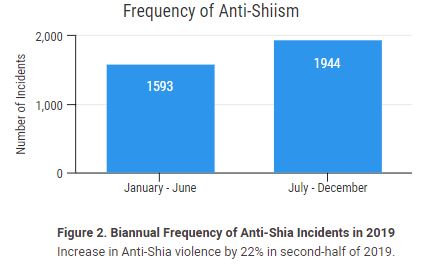
Shia Rights Watch notes the change in the reported frequency of violence in the first half of the year relative to the Biannual report. This change is a function of delayed reporting of survivors of violence due to fear and lacking communication resources, as well as an increased death count traced to incidents of violence previously reported. These numbers include victims who were initially injured and were deceased after the publishing of the Biannual report. Shia Rights Watch updates its reporting with respect to lives lost as a result of Shia rights violations.
Annual Trends
The primary forms of direct acts of anti-Shiism are killings, wounding, arrests, and sentencing. Of the 3,537 incidents of recorded anti-Shiism, approximately 109 are reports of cultural and systemic violence.
Shia Rights Watch has categorized such violence as “others” and notes that each cultural and systemic incident of violence affects countless Shia Muslims and has international implications.
“Other” in classification include, but is not limited to the following: 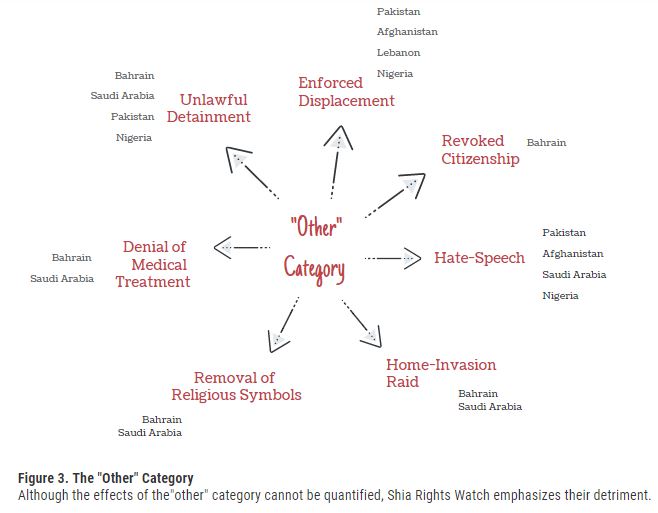
- Denial of medical treatment
- Unlawful detainment
- Enforced displacement
- Hate- Speech
- Closing of Shia religious centers
- Removal of religious symbols
- Home-invasion / Raid
While Shia Rights Watch attempts to quantify forms of violence in an “other” category, the organization emphasizes that the detriments caused by such violence cannot be truly measured as they have both short term and long term, physical, and psychological effects.
Political Associations of Shiism
As an approximate population of 120 million, Shia Muslims live as residents and natives of various nations across the globe. They have diverse political ideologies and exist as multiple ethnicities.
In the past decade, however, Shia Islam has been vastly generalized into a single political identity under the influence of Iran. Shia Muslims in Saudi Arabia, Iraq, Pakistan, among other nations, are perceived to be promoters of values of the Islamic Republic of Iran. This perception is fueled by political propaganda and the nation’s history of Shiism.
Iran is not the first nor the last majority – Shia nation. Historically Shia Muslims have risen to power in many global regions (i.e., Fatimid Dynasty of 909) and have displayed the religious ability to stand independent of politics. Shia Islam, in itself, is not an affiliation but an ideology, free of any political tie. Based on Shia doctrine, mosque and politics are independent, and the only role religion plays to act as a check and balance of government jurisdiction and in protection and representation of the people.
The association of Shia Islam and Iran is destroying communities at large. Shia in various countries refuse association with Iran- many have not even been exposed to Iranian influence. Shia populations stand loyal to their nations and have shown the same citizenry to their resident countries as any other population. This publicized affiliation only strengthens international Iranian influence. It leaves nations fractionated and weak in response to extremist organizations, costing the lives of thousands, if not millions of men, women, and children. The association of religion to politics is not only counterproductive but also destructive.
In 2019, the nation of France joined the list of countries that fell victim to false associations of Shiism with Iran. In March, French Interior Minister Christophe Castaner closed down four Shia centers under the guise of them being backed by Iran. Giving in to ignorance, Castaner victimized French Shia Muslims.
Shia Muslims have long expressed independence from any political entity, and the minister’s failure to recognize Shia Muslims as an independent religious group was met with condemnation.
France is not the first nor the last nation to politicize its Shia residents and citizens. And while the actions of Minister Castaner was public and immediately recognized, the association of Shia Islam with a single political identity exists as unrecognized and unconscious discrimination.
Shia Rights Watch emphasizes that the association of Shiism with a singular political identity is dangerous. Shia Islam must be recognized as a multi-cultural, multi-ethnic decentralized identity and unrequited associations must be altered as a means of reducing anti-Shia violence.
Efforts to Address Anti-Shiism
In 2019, aims to address violence against Shia Muslims were taken in Sri Lanka, Pakistan, and the United States of America. While these measures were met with gratitude upon their occurrence, Shia Rights Watch highlights these pioneering promotions of religious freedom in this report.
Sri Lanka
In correspondence with the holy month of Muharram, the Sri Lankan Colombo Hultsdorf Magistrate courts ordered restraints against two nationalist groups, ‘Sinhala Jathika Balamuluwa’ and ‘Ravana Balaya,’ upon discovery of plans to disrupt Shia gatherings in the Bambalapitiya area of Colombo. Colombo authorities increased security around the Shia religious center and its surrounding neighborhoods.
Colombo Sri Lanka is home to approximately 25,000 Shia Muslims.
Pakistan
Authorities in Karachi, Hyderabad, Peshawar, Islamabad, Mirpurkhas, Shaheed Benazirabad, Sukkar, Larkana, and Nawabshah increased security by 69,545 to protect Shia mourners for the holy day of Ashura in which Shia Muslims commemorate the martyrdom of Hussain, the grandson of Prophet Mohammad.
The Sindh province declared the 9th and 10th of September, days with the highest processional attendees, as public holidays and cut off mobile services that could empower explosives. On rare occurrence of medical emergencies, six operation theatres, 16 ambulances, and 422 medical personnel were placed on high alert in Lady Reading Hospital.
Across Pakistan, mourning processions and gatherings were anticipated, and routine traffic was rerouted to reduce the feasibility of attacks.
The new measures not only protected Shia Muslims, but they also prevented violence that led to the loss of life and damage to property of non-Shia individuals.
United States of America
New York University students discussed minority identities and physical appearances in an event titled, “Making the Marginalized Mainstream: Being the Minority within a Minority.”
Participants noted feeling marginalized by their “own community” based on their Shia beliefs and even more discrimination based on skin color. Nawal Ali, a panelist at the event, noted the hidden power of being a minority, “Even though I might have felt I wasn’t part of the mainstream, being different is your superpower,” Ali said. “I don’t know if mainstream should be our goal, but by being unapologetic, we might be a window to Islam for somebody else, educating them.”
The above measures are explicit examples of decisive action that can be taken to promote minority rights. Shia Rights Watch encourages standards, legal and at a grassroots level, to reduce and prevent human rights violations. More information in regards to each of the above measures can be found at ShiaRightsWatch.org.
Counter Productive Policy
Poorly designed policy not only does not meet intended goals, but it can cause detriment to constituents. In this section, Shia Rights Watch highlights policy interventions undertaken in 2019 that counter to their aims of promoting human rights.
India’s Citizenship Amendment
Indian lawmakers approved an amendment to the nation’s Citizenship Law allowing illegal migrants who have lived in India for five years to apply for citizenship. The bill specifically eased naturalization for Hindu, Sikh, Buddhist, Jain, Parsi, and Christian individuals from Pakistan, Bangladesh, and Afghanistan, while ignoring the multitude of other minority religions and identities in these nations.
The adopted changes eased immigration for thousands of migrants but, for the first time in Indian history, created a provision for religious identity to serve as a basis for granting citizenship.
The bill caused an outcry in the Muslim community as it explicitly discriminated against Muslims.
As it pertains to Shia Muslims, the bill has dangerous implications. The law limits Shia Muslims fleeing prosecution, especially as it sets precedents in the region to explicitly limit migration based on religious identity. Already a targeted group, the new bill excludes Shia groups such as the Hazara from Pakistan, Bangladesh, and Afghanistan- all countries included in the statement. Exclusions of the Shia from the law is a fierce display of biased policy as these groups have been established as endangered minorities in their native nations. As for Shia native to India, many may be expelled to countries in which their lives are targeted by active anti-Shiism.
The Indian government claimed the law serves to present India as a haven for groups discriminated against in neighboring nations. Counter to their declared goals; the amendment marginalized other religious groups and signals the acceptability of intolerance and prejudice.
Residence by Religion in Lebanon
Lebanon has long established itself as a multireligious nation. Yet in an incident on June 26, in the town of Hadath, southeast of Beirut, a Shia Muslim couple was denied their right to rent a property. The property owner told the couple that a law established by Hadath’s officials prohibited Muslims from renting or buying Christian property. Only Christians are allowed to buy or rent property in Hadath. It is important to note that Hadath is on the edge of an area known as Dahiyeh, Beirut’s densely populated Shia area, and those who seek to reside in Hadath are Shia.
The Mayor of Hadath, George Aoun promoted sectarianism in a statement saying,
“Every village should preserve itself. Every Shiite village should preserve its Shiite nature, every Christian village should preserve its Christian nature and every Sunni village should preserve its Sunni nature. We want to preserve our village or what remains of it.”
This incident was the only one publicly announced. Still, it has become more and more common in other Lebanese cities in east and south Lebanon to limit residence to specific religious sects. Local lawmakers are adopting legal measures that would make it harder for non-Christians to buy and operate the property in their jurisdiction.
Mayor Aoun and his like claim to protect their communities. However, they are instigating identity-based restrictions that breed intolerance in Lebanon.
Limited Hazara of Pakistan
The Hazara are an ethnic group of Shia Muslims that originate from the historic town of Hazarajat, Afghanistan. They have long been the target of anti-Shia violence, so much so that Shia Rights Watch estimates that only a fraction of their population has survived ethnic cleansing over the years.
Quetta, Pakistan, is home to a substantial population of Hazara diaspora. In July, security forces were deployed to Hazara districts of Quetta as a means of reducing targeted violence. The community, however, notes that as a result of increased checkpoints and security inspections, they have been marginalized from the greater society.
While the increased checkpoints aimed to reduce potential violence, they inadvertently marginalize the Hazara residents and deter business by limiting passage in and out of the area.
Shia Rights Watch acknowledges the need for top-down interventions to protect religious minorities. Top-down policies, however, can also have negative implications if they are not representative of their constituents and their needs.
Country Based
Anti-Shiism is present in various forms and is unique to its target Shia population. Shia Rights Watch gathers information concerning violations against Shia Muslims in all nations of their residence. The incidents included in this report are only a sample of violence that threatens Shia Muslims. Thus this report must be used as a window into Anti-Shiism. Moreover, points and trends noted in this report serve as first stepping stones into interventions that can reduce and eliminate violence against Shia Muslims.
In the following section, trends of violence specific to each nation will be presented.
Afghanistan
Afghanistan is home to approximately 8 million Shia Muslims. Primarily, the Shia population native to Afghanistan consists of Twelvers or those who believe in the successorship of 12 infallible leaders following the martyrdom of Prophet Mohammed.
Shia populations in Afghanistan historically exist as ethnic communities, the most prominent of which is the Hazara group. With the rise of terrorist organizations like al-Qaeda and the Taliban, Shia communities disbanded ethnically. In response to increased violence, both direct and cultural, some Afghan Shia practiced in private in fear of being targeted. 
Despite efforts to conceal their identities, the nature of Shia rituals makes pockets of Shia communities identifiable. Attacks are mainly designed to target the maximum number of Shia civilians. Targeting is indiscriminate to the age or gender of victims.
In total, 744 Shia men, women, and children were killed and wounded in 2019. Improvised explosive devices were the most common medium of violence.
Perpetrators of anti-Shiism are mainly violent aggressors from existing terror organizations, including but not limited to the Taliban and ISIS-affiliated groups. The nature of the attacks exemplifies radical extremism fueled by the dehumanization of those perceived to be deviants from the secular extremist ideologies promoted by these organizations.
Attacks against Shia Muslims occur in mosques, celebratory and commemoratory congregations, and cultural or educational centers.
Shia Muslims and non-Shia sympathizers are killed in bombings. Others are injured and communities, Shia and non-Shia live to endure the infrastructural and psychological damage caused by terror attacks. Terror attacks cause more injury than they do loss of life. While this may point to the inaccuracy of bombings, Shia Rights Watch, notes that these attacks maximally fulfill their potential to marginalize Shia Muslims by presenting them as high-risk group associations.
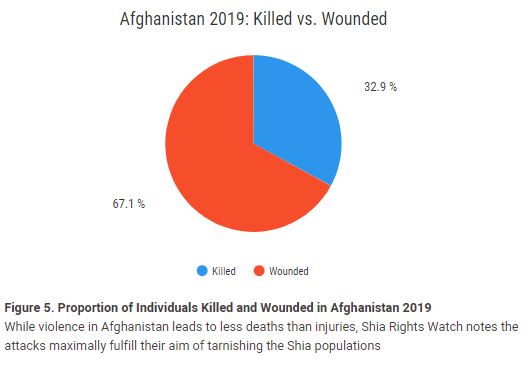 Two-wave attacks are frequent in the hands of terror organizations. Not only do extremists want to eradicate Shia Muslims, but they also wish to eliminate anyone who empathizes with victims of anti-Shiism. After an initial explosion that targets Shia congregations, a second attack targets those who provide aid or support to Shia Muslims.
Two-wave attacks are frequent in the hands of terror organizations. Not only do extremists want to eradicate Shia Muslims, but they also wish to eliminate anyone who empathizes with victims of anti-Shiism. After an initial explosion that targets Shia congregations, a second attack targets those who provide aid or support to Shia Muslims.
The attacks against civilians have resulted in extreme fear and paranoia, preventing Afghan Shia from attending religious and cultural programs. Such violence not only threatens the lives of the people but also harms their overall participation in society.
Bahrain
In 2019, 1329 incidents of violence were reported in the Kingdom of Bahrain, 500 of which were the function of raids.
Arrested and summonings are the most prominent form of anti-Shiism in Bahrain. Injuries have been the result of violence in raids and failure to maintain minimum health and sanitation requirements for prisoners.
Prison Conditions
Medical negligence is a prominent form of violence in the hands of authorities at detention centers, such as that of Jaus. Prisoners with existing conditions are prevented from follow up medical attention, and families report that living conditions are worsened by torture and solitary confinement. Some prisoners report having spent as much as 23 hours a day in solitary.
In the final months of the year, scabies ran rampant among detainees. Scabies, a contagious skin rash caused by mites, is an easily treatable condition, yet authorities within detention centers have failed to attend to prisoners.
Increased Limitations on Social Media
In 2019, the Bahraini lawmakers made definitions of terrorism broader than ever before, thus allowing more critics of the government to be placed behind bars on actions that the United Nations would classify as free speech.
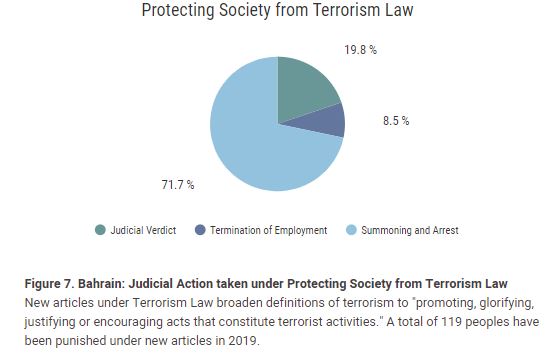
Adoption of the new legal measures makes even retweeting and following criticizing social media accounts acts of sedition. Criminalization of freedom of expression in the media occurs through 21 articles under the Protecting Society from Terrorism Law with penalties ranging from fines to imprisonment for promoting, glorifying, justifying, or encouraging acts that constitute terrorist activities, which themselves are defined arbitrarily by presiding judges.
As a result of the newly adopted articles, 119 violations have been recorded including 76 incidents of summoning and arrests, 21 judicial verdicts against social media journalism and 9 cases of termination of employment, or threats thereof; 51 of the summonings were of preachers and eulogy reciters active during the first ten days of Muharram alone.
Alternative Punishment Law
While rights-based violations exist and continue to threaten the livelihood of Shia Muslims in Bahrain, increased use of the Alternative Penal Code adopted in 2017 has served as a beacon of hope for some families. 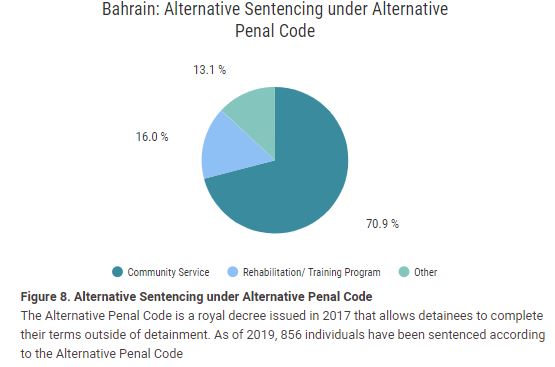
The Alternative Penal Code is a royal decree issued in 2017 that allows detainees to complete their term outside of traditional detainment centers.
Under this law, prisoners who: served over half of their sentence, paid financial dues and are in good conduct can complete their punishment in the forms of community service, house arrest, confinement within a particular place, refraining from entering a particular place or places, limitations in communicating with particular persons or entities, submitting to electronic surveillance, attending rehabilitation and training programs, and remedying the damage that resulted from the crime.
Moreover, “any convicted person sentenced to imprisonment of not more than one year or physical coercion may request the Execution Judge to substitute the imprisonment sentence or physical coercion by one or more of the alternative sanctions set forth in Article 2 of this Law. The execution judge shall decide upon such a request after hearing the statements of the Public Prosecution.”
Thus far, 856 individuals have been sentenced according to the Alternative Penal Code.
While the law provides hope for many detainees, it remains under heavy criticism from the Shia community in Bahrain. The new alternatives allow for increased long and short term limitations in the financial and psychological well being of pro-democracy activists. Moreover, the laws disintegrate Shia communities and present dangers of possible indoctrination of these individuals against their communities in fear of return to prison. While the government has eluded to the new penal code as a public good, the alternatives have unilateral benefits and created minimal grounds for social and human rights.
For instance, Article 3 of the Law in which community service can be made as an alternative punishment, allows for unpaid employment in roles similar to occupation or profession previous to detainment. Shia Rights Watch notes this alternative aims to counter the increasing failure of social structures as the result of protests which left national service positions lacking workers. Moreover, the organization notes that placing Shia Muslims within posts of occupation without any compensation, financial or resources, opens the way for the public and private sector to violate their employees through disproportionate workload and a malevolent psychological environment.
Given the lack of measures that would ensure equal rights in the workplace and the existing hostility against activists, monitoring the after-effects of the alternative penal code must occur.
Similar concerns stand for other alternatives such as the rehabilitation and training programs that stand as the second most prominent alternative punishments. Under Article 8 of the Penal Code, “attending rehabilitation and training programs shall take effect through compelling a convicted person to undergo one or more of the medical, psychological, social, educational, occupational or industrial rehabilitation and training programs to reform his behavior.”
Noting a history of prominent Saudi Arabian influence in the Kingdom of Bahrain, Shia Rights Watch also fears the inclusion of religious indoctrination within training programs.
Indoctrination can be detrimental to the Shia identity, especially as the law calls for refraining from “communicating with particular persons or entities” and “submitting to electronic surveillance,” all of which can lead to the marginalization of previously convicted Shia persons from their larger Shia community.
Nigeria
Shia Islam is the largest growing religious minority in the African continent. The nation of Nigeria is home to the region’s densest population of Shia Muslims. Activists estimate 4 million Shia Muslims in Nigeria.
Anti-Shiism in Nigeria continued in 2019. The most prominent case of anti-Shiism is that of Sheikh Zakzaky and the Islamic Movement in Nigeria (IMN).
Zakzaky and his followers in Kaduna were first recognized in December 2015 when their congregation was attacked by the Nigerian army during religious processions. The single incident led to the death of 400 Shia Muslims, the majority of whose families were refused ritual burials. Bodies were later discovered in mass graves.

In July of this year, the IMN was banned and outlawed by a Nigerian court on assumptions that the group acts in association with the Islamic Republic of Iran, and the association that Shia Rights Watch has warned to be dangerous and detrimental to basic human rights.
In September 2019, Agnes Callamard, the United Nations special rapporteur on extrajudicial, summary or arbitrary executions condemned violence against the Islamic Movement in Nigeria led by Sheikh Zakzaky after a 12-day investigation. Callamard noted “arbitrary deprivation of life” and the excessive use of lethal force against protesters. Moreover, she stated that evidence of alleged weaponization of the group is lacking and that the Nigerian authorities lack sufficient justification for their actions against the group. Callamard cautioned against violence and warned the violations in the hands of authorities could destabilize the African region.
None-the-less, Sheikh Zakzaky and the IMN remain a point of contention. Sources close to Zakzaky report deteriorating health after a stroke last year. A toxicology examination in June 2019 found high levels of cadmium and lead in Zakzaky’s blood. Moreover, medical examinations showing the loss of eyesight and further complication to his pre-existing cardiac condition. Protestors took to the streets calling for attention to the leader’s health.
In July, clashes between protestors and government soldiers led to the immediate death of 19, injury of 5 and the arrest of 159 Shia Muslims; 38 of those arrested were arraigned in court in the week following the clash.
Following the rising contention, the Kaduna State High Court ordered the release of Zakzaky allowing him and his wife, who is also detained and suffering from injuries incurred in previous attacks, to undergo medical treatment in India. Femi Falana, the Zakzaky counsel noted that the government of Nigeria warned the couple against seeking asylum in India and that the couple’s travels would be strictly escorted by security forces. On August 12 the couple arrived In India for treatment. Upon arrival, a statement by Zakzaky was released expressing grievances of limitations imposed by the government of Nigeria amidst his travels. He stated,
“After we arrived we realized that in this hospital, or better yet someone working in the Nigerian embassy here told us that before we came, they had carried out a meeting with the hospital staff, the workers from the Nigerian embassy and some security operatives on how to go about things once we are here.
So we saw that we were practically brought to another detention facility which is even stricter than the one we were in back in Nigeria. They came here with police armed with guns and a lot of staff from the Nigerian embassy. And we also noticed we were brought into another detention that we only came based on trust.
Even in Nigeria, they agreed where we were detained that we would be treated only by the doctors we choose and are comfortable with allowing us to treat us. But here we understand that the doctors that advised us to come here are blocked from having any say in our case. They even told us when we spoke to them, they are only allowed to advise but the hospital reserves the right to decide the course of our treatment. So I told them that, we came here based on the trust we have in our doctors, we cannot just see any doctor that we don’t know, or trust to treat us. And without a recommendation from those we trust, we cannot allow a stranger to treat us, lest not what couldn’t be done with bullets be carried out in a different way.
Due to this, we think that based on everything we have seen so far indicates to us that we are not safe here. We were just brought to another detention.”
Fueled by mistrust in Nigerian influence in their treatment, the couple returned to Nigeria within days without completing necessary treatments. Upon arrival, they were taken to undisclosed locations. Since their return little has been disclosed of the state of Sheikh Zakaky and his wife. The couple remains in custody with no developments in their case.
The Islamic Movement of Nigeria community, however, remains under the assault of national forces. On processions in commemoration of Ashura, the tenth day of the holy month of Muharram and the anniversary of the death of Imam Hussain, government forces attacked mourners killing 12 individuals and injuring dozens of others. The congregation of the group was also violated in December as hundreds gathered in memory of lives lost in 2015 in state-authorized violence that killed hundreds of Shia Muslims.
While the IMN and Sheikh Zakzaky have gained international media attention, Shia Rights Watch wishes to highlight the nature of non-associated Shia Muslims in Nigeria. Given the treatment of Zakzaky and his community, it can be assumed that Shiism in Nigeria is not openly accepted. Shia Rights Watch notes that inquiry is needed into the existence of cultural and systemic discrimination against identified Shia Muslims in Nigeria. The organization recognizes the fears and lack of security which may limit the expression of the Shia identity, and also highlights the need for understanding the conditions of life for Shia Muslims who do not associate themselves with the IMN.
Pakistan
Pakistan stood witness to 255 incidents of anti-Shiism in the year 2019.
In the first half of the year alone, 160 Shia Muslims were killed or injured. The majority of violence is the result of the detonation of explosive devices placed in locations dense with Shia presence.
The most prominent forms of violence in the nation were death or injury as the result of a mass killing of Shia communities, namely the Hazara, and the targeted killings of prominent Shia individuals.
Mass Killings
Quetta has been the target of the nation’s highest frequency of bombings. The site of a large population of Hazara Shia Muslims, the city of Quetta is largely targeted by terror organizations. Suicide bombers and car bombs are often detonated in market places or places of the congregation to maximize loss of life.
In April, the terror group Lashkar e Jhangvi initiated an attack in Quetta with explicit aims to “target the Hazara community”. The attack led to the death of 20 and the injury of 48 others. In May, another explosion near a Shia mosque rocked Quetta killing four and injuring dozens of others. Later in August, an improvised explosive device detonated under the chair of the prayer leader inside a mosque, again in Quetta, killing four.
Two-step explosions have been used on numerous occasions to ensure the killing of Shia Muslims as well as sympathetic aid workers.
Outside Shia dominant locations, Shia Muslims also face danger. In June, Hazara Shia again were the target of extremism. Two individuals were killed in an explosion in Ziarat, Balochistan as they traveled for “sightseeing” of the region.
Assassinations
Notable Shia Muslims in positions of social power at higher risks of being targeted all over Pakistan.
In January, the vice-chairman of the Shia Council, Mohammad Ali Shah was shot in Karachi. In March, Sayyed Hussain Shah, the Superintendent of the Balochistan University was shot by an unknown assailant.
Assassinations are a prominent form of anti-Shiism in Pakistan. Prominent Shia Muslims in a position of power are targeted and killed in a shooting by unknown assailants on-route. While assailants are known to be motivated by radical ideologies of terror groups in the area, they are rarely identified and arrested. Shia Rights Watch posits that individual targeting of prominent Shia Muslims is a means of thwarting the rise of Shia Muslims to positions of power to influence society. Moreover, they aim to signal the intolerance of Shia Muslims in legislative and educational institutions in the country.
Such intolerance for Shia Muslims was also evident in the call for the removal of the Vice-Chancellor of Bacha Khan University, Saqlain Naqvi, in Charsadda in December 2019. Protestors invoked Naqvi’s Shia identity as a means of inciting support for his removal.
Identifiable Shia Muslims are also the target of extreme violence. In June, Muzamil Abbas was beheaded by two extremists in Punjab. The assailants had identified and targeted Abbas by his necklace which bore the name of Ali, a prominent Shia Imam.
Measures to Counter Violence
Within the past year, efforts to reduce anti-Shiism were taken.
In 2019, Shia Rights Watch recognized Pakistan’s preparation for Muharram processions. Authorities reported increased health and approximately 70,000 security services in areas dense in Shia population, including Karachi, Hyderabad, Peshawar, Islamabad, and Nawabshah. Moreover, authorities warned against anti-Shia propaganda and hate-inciting publications. Plans for rerouting traffic to reduce congestion as well as reduce incidents of violence were announced in advance.
Shia Rights Watch expressed gratitude for the protection of religious expression and the prevention of violence that could have led to the loss of life and damage to property of non-Shia individuals. More information on this issue can be found on ShiaRightsWatch.org.
While efforts to reduce violence signal development in the nation, some measurements have been counterproductive. For instance, in July, security forces were deployed to the Hazara districts of Quetta as a means of protection. The community, however, notes that as a result of increased checkpoints and security inspections, they have been marginalized from the greater community.
The criticisms of the new measures by Shia Rights Watch sources point to a failure of the authorities to include Shia communities in the planning of efforts to address anti-Shiism. In order to meet the needs of survivors of violence, Pakistan must include Shia Muslims in city planning and encourage community-level interventions that empower communities against violence.
Iraq
The year 2019 stood witness to 502 incidents of anti-Shiism in Iraq. This reported number is void of any incidents of violence against protesters as their motivations were not the religious identity of individuals but their political ideologies. Shia Rights Watch approximates at least 25,000 incidents of violence (injury and death) against Shia individuals protesting the political climate in Iraq. Shia Rights Watch expresses its sympathy for all lives lost in the struggle for freedom of expression and rights.
The most prominent form of anti-Shia violence in Iraq was that of assassinations, or targeted shootings, and bombings. 
Assassinations in Iraq are prominent across the north and south. Unknown assailants target identified Shia Muslims, typically male, and kill them using handheld guns on transit. Kidnapping and killing were common by ISIS assailants as their territorial reign retracted. While evidence for ISIS activity exists in limitation, Shia Rights Watch posits that the same anti-Shia sentiment that fueled the success of ISIS enforces violence against Shia Muslims today.
It must be recognized that there are many incidents of violence that remain unreported. Grassroots activists state that many families do not report loss of life in fear of being recognized as Shia Muslims. Moreover, many fear that reporting anti-Shiism would instigate retaliatory tribal violence. Thus, the 502 incidents of violence in Iraq can only be taken as a sampling window into the dynamics of violence in the nation.
Shia Rights Watch sources within Iraq report numerous dismantled explosive devices in cities such as Samarra which have a heavy presence of security sources. Dismantled bombs were also found in Baghdad. Successful prevention of direct violence is a source of hope that violence prevention can be possible with increased security measures.
Saudi Arabia
Saudi Arabia was the home to a total of 187 incidents of anti-Shia violence. 
Approximately 51% of deaths in Saudi Arabia were the result of executions. Executions in Saudi Arabia occur en-masse. Those executed were charged with terrorism and charged on confessions extracted after torture and tried in sham trials with severely lacking due process.
Among those executed were individuals such as AbdulKareem al-Hawaj who was arrested as a minor for participating in pro-democracy protests.
Executions have become an increasingly popular form of punishment in the Saudi Arabian judicial system; with 184 total executions, 2019 marked an all-time high in the number of executions in one year.
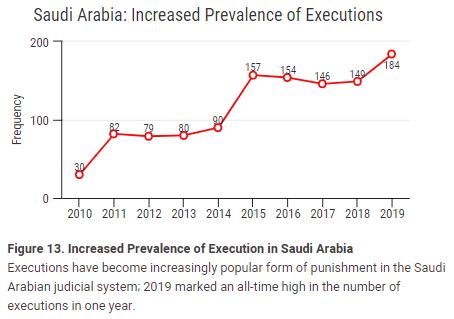
Raids were the second-most prominent form of violence with which Shia Muslim were killed. Frequently throughout the year, raids were carried out in areas with a majority Shia population. Late at night or at dawn, security forces flood Shia neighborhoods and instigate fear by shooting at infrastructure and cars. Homes are entered unlawfully and individuals suspected of pro-democracy activism are taken. As a result of unprecedented violence, a number of Shia Muslims have been killed in raids.
The year 2019 also stood witness to the death of a number of detainees as a result of failure to address detainee health concerns. The brutal conditions in Saudi detainment centers have lead to the death of three detainees in 2019. Dissident Saudi cleric Sheikh Saleh Abdulaziz al-Dumairi died of health complications he had developed at Tarfiya prison; Dumairi suffered from heart problems and was being kept in solitary confinement.
Nayef Ahmed Al-Omran died in detainment due to neglect by prison authorities. Hussein Ali-Abdul Aziz al-Ribh, arrested in 2017, died in Dhahban Central Prison in November following torture.
Families of victims who have lost life in raids or while in detention have been largely denied access to the body of their loved ones. Sources stipulate that bodies of individuals that die in detention are withheld with the aim of hiding evidence of torture and maltreatment.
Conclusion
Anti-Shiism remains a prevalent international issue. Imprisonment, denaturalization, injury, loss of life, life-sentences, kidnapping, denial of services, arrests and property damage are types of violence reported to Shia Rights Watch. This report only presents quantifiable incidents of anti-Shiism. Each incident extends to tens of unquantifiable cultural violence, including but not limited to marginalization, stigmatization, and scape-goating of Shia communities.
Prevention of violence is possible.
While violence against Shia Muslims continued, the year 2019 also stood witness to numerous measures that aimed to address anti-Shiism; 2019 showed that preventing violence is possible. Executive-level sanctions against violators of human rights in Sri Lanka and Pakistan were a display of actions that policy-makers and executors can take to signal intolerance towards targeting of minority groups. Events at New York University also show that a platform for discussing the dynamics of minority groups can be created.
Parallel to interventions that positively impacted pro-rights efforts were interventions that were ineffective, and in some cases even detrimental, to minority communities. Such counterproductive policies lacked the inclusion of at-risk communities and an overall understanding of the possible unintended implications policy may have.
Having experienced anti-Shiism first hand, Shia Muslims can provide unique perspectives on the needs and the potentials of this group in reducing violence.
To the Shia Communities and Activists:
Build Community Capacity and Agency
At a community level, Shia Muslims must work to develop and strengthen processes and resources that promote community cohesion and resilience. Shia Muslims can build an active, educated and aware network that promotes justice and condemns human rights violations against all religious minorities, including their own.
To do so, Shia Muslims must first acknowledge concerns of anti-Shiism in their international communities and then adopt agency to address violence-related trauma in their respective communities.
Subsequently, Shia Muslims must build bridges with their legislative representatives. By participating in dialogues and volunteering for initiatives that directly and indirectly support their community, Shia Muslims can become active citizens to both their Shia communities and their greater national society.
The top-down policy has the power to create change on a national and international scale.
To National and International Policy-Makers:
Establish Judicial Justice
In one form or another, Shia Muslims are threatened by the failure of due justice. In nations such as Saudi Arabia, Bahrain, and Nigeria, Shia activists are detained and denied a fair trial. In some cases, policies and laws are amended in a manner which criminalizes Shia rituals such as religious congregation. Shia Rights Watch urges nations to enforce judicial justice by ensuring fair trials, abolishing the death penalty (especially for minors), banning travel impositions, halting revocation of citizenships, and complying with international laws and standards.
Moreover, in nations such as Pakistan and Afghanistan, Shia individuals have reported a failure in their judicial systems to effectively prosecute agents of anti-Shiism. Shia Rights Watch calls on leaders to secure justice for religious minorities through investigation in anti-Shia incidents.
Include Shia Muslims Explicitly
In recognition of the marginalization of Shia Muslims by extremist ideologies, the explicit recognition of Shia Muslims as active, yet targeted, members of the country can legitimize the Shia identity. Examples of such action would be the allocation of resources, protection of the group in locations with dense Shia population and the establishment of entities as a communication bridge with community leaders.
The explicit recognition of the group empowers Shia Muslims to further their participation in their greater national communities. Moreover, to groups within the nation and to foreign powers, the recognition and protection of religious minorities signal intolerance towards targeted violence and cultural discriminations. Subsequently, the inclusion of Shia Muslims in policy-making allows for targeted policies that can truly address the needs of the community and thus reduce possible negative implications.



